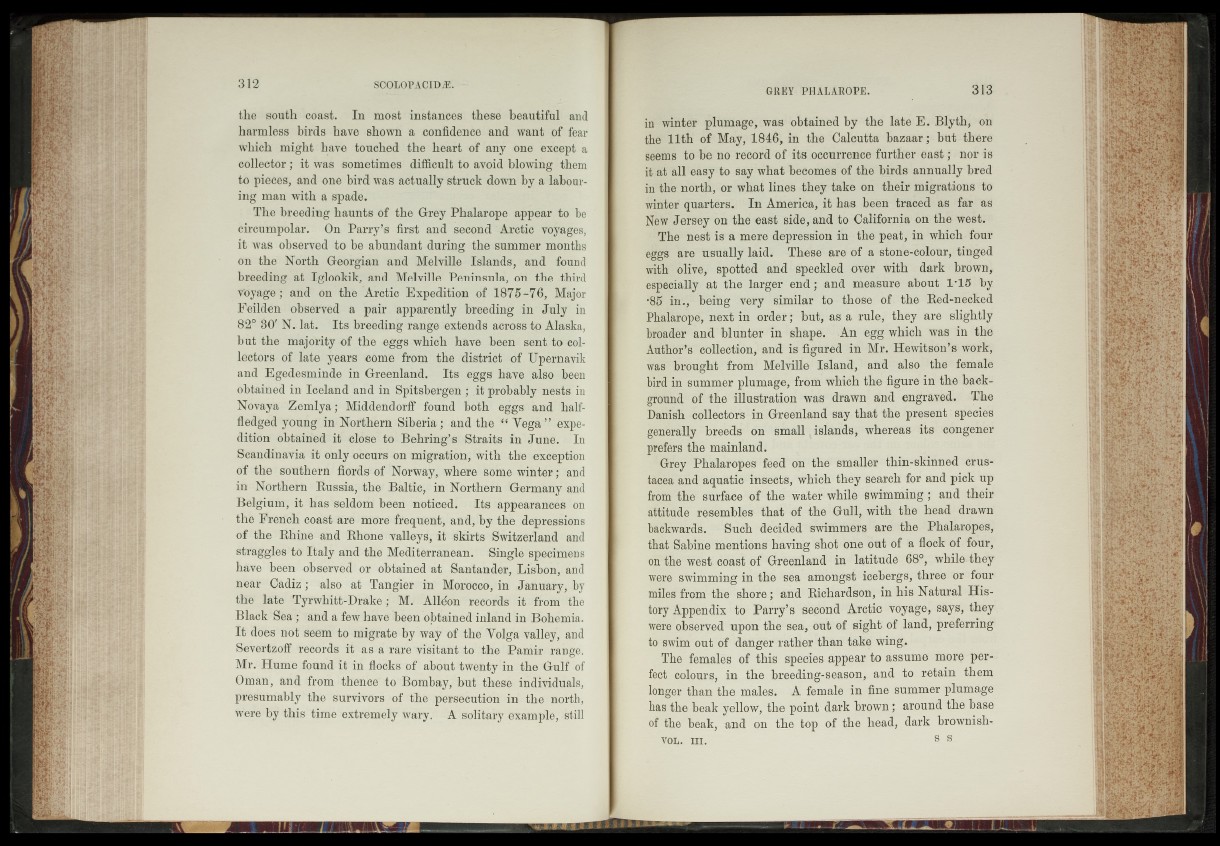
the south coast. In most instances these beautiful and
harmless birds have shown a confidence and want pf fear
which might have touched the: heart of any ©ne except a
collector; it was sometimes difficult to avoid blowing them
to pieces, and one bird was actually struck down by a labouring
man with a spade.
The breeding haunts of the Grey Phalarope appear to be
circumpolar. On Parry ?s first and second Arctic voyages,
it Was observed to be abundant during the summer months
On the North Georgian and Melville Islands, and found
breeding at Iglookik, and Melville Peninsula, o'd the third
voyage; and on the Arctic Expedition of 1875-76., Major
Feilden observed a pair apparently breeding in July in
8H? to' N. lat. 'Its breeding range ^extends across>tp Alaska,
but the majority of the eggs which have been sent, to'collectors
of late years come from the district of Upernayik
and Egedesminde in Greenland. Softs’ eggs have also heen
obtained in Iceland and in Spitsbergen; /it probably nests in
Novaya Zemlya; Middendor# found both eggs- and half-
fledged young in Northern Siberia; and the “ Yega’’^expedition
obtained it" close to Behring’s -Straits in June. £iln
Scandinavia; it only occurs on migration /with -the ‘^exception
of- the southern fiords of Norway, where -Sehje winter; 'and
in Northern Russia, the Baltic, in Northern Germany and
Belgium, it has Seldom been notice'dl Its appearances' óh
the French coa-St are more frequent, and, hy the depressions
of the Rhine and Rhone Valleys, it Skirts Switzerland and
straggles‘to Italy and the Mediterranean. Single:specimens
have been -observed or obtained at Santander, Iasbon,-and
nea-r Cadiz; salso at Tangier in Morocco,-in -January, Ay
the late Tyrwhitt-Drake; M. Alléon^WcO^ds: it-from ffiè
Biack Söa; and a few havé" heen obtained inland in Bohemia.
It d&es not seOm to -rtiigrateby way of the V'oiga'WallêyVand
Severtzoff records it as-a r^re -visitant |t®' 'the Pamirftrabge.
Mr. Hume found it in flocks of about twenty fin * the 'Gulf of
Oman, and from thence to Bombay, but these'individuals,
presumably the survivors >of 'the persecution inf- the -north,
Weis *by this time extremely wary. A Mitary example, still
in winter plumage, was obtained by the late E. Blyth, oh
the 11th of May, 1846, in the Calcutta bazaar; but there
seems to be no record Of its occurrence further east; nor is
it at all eaBy to say what becomes of the birds annually bred
in the north, or what lines they take on their migrations to
winter quarters. In America, it has been traced as far as
New Jersey onfthe east side, and to California on the west.
The nest is a mere depression in the peat, in which four
eggs are usually laid. These are of a stone-colour, tinged
with olive, spotted and speckled Over With dark brown>
especially at the larger end; and measure aboufc 1*15 by
‘85 in.,^Aeing very’ similar to those of the Red-necked
Phalaropë, nëxt in order ; but,-aS a rule,'' they are slightly
broader and blunter in shape. An egg-which wasjan the
Author’ S*5 collection, and is figured in; Mf. Hewitson’s work,
was brought from Melvilfe Island, and also the female
bird in summer plumage, from which the figure in the background
of'the illustration was drawn and engraved. The
Danish collectors in Greenland say that the presentg species
generally breeds on small, islands, whereas its congener
prefers the mainland. -
Grey Phalaropes ‘feed' on the smaller thin-skinned Crustacea
and aquatic- insects,- which they search for and pick up
from the surface of the water while swimming; and t-heir
attitude resembles that of the GAll, with the head drawn
backwards. Such decided" swimmers are the. Phalaropes,
that Sabine mentions having shot one out of a flock of four,
ort’the'west', coast of Greenland in latitude 68°, while.they*
were swimming i-n the sea amongst-'icebergs, three- or -foui«
miles from the shore; and Richardson, in his Natural History
Appendix to- Parry’s second Arctic ‘veyage^-says, they
were observed upon the sea, out ©f sight of land, preferring
to swim out of danger rather than take wing.
The females of this species appear to assume more - perfect
.colours, in the breeding-season, and to retain them
longer than the males. A female in fine summer plumage
has the beak pillow, the point dark brown; around the base
of the "Beak, -and orf the top of the head, dark brownish-.